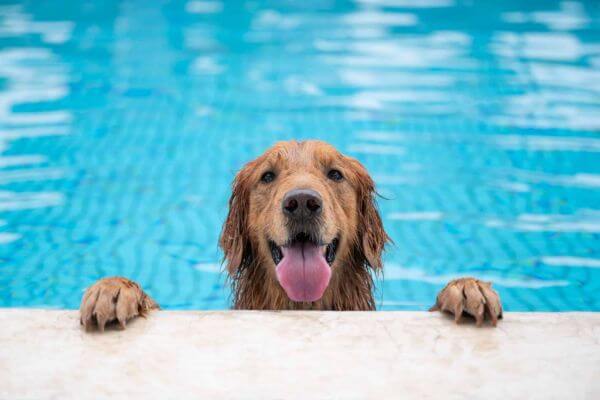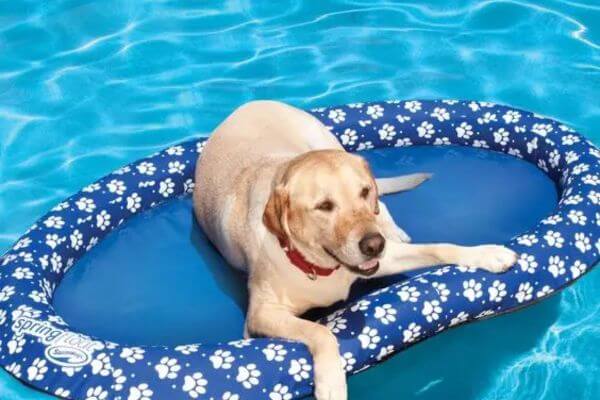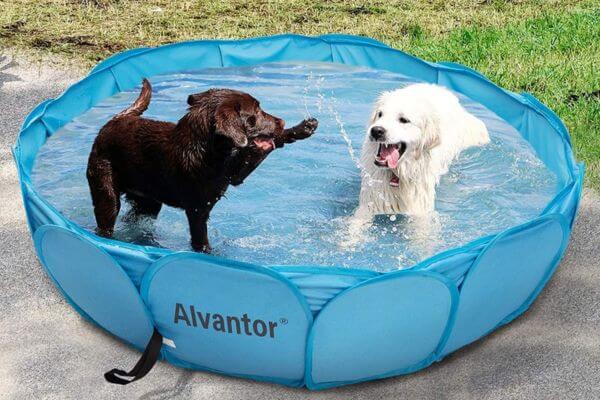Dog owners know that their furry friends love nothing more than a good swim on a hot summer day. But not all dogs have access to natural bodies of water, and even those who do may not be able to enjoy them safely.

This is where the dog pool comes in – an excellent way to cool off and exercise during the summer months. A dog pool can offer numerous benefits for both dogs and their owners.
For one, it provides a safe environment for dogs to swim and play without the risk of drowning or encountering dangerous creatures such as snakes or alligators. Additionally, swimming is a low-impact exercise that can benefit dogs’ health by improving their cardiovascular fitness, joint mobility, and muscle strength.
Watching your furry friend frolic in the water will surely bring a smile to any dog owner’s face. In this article, we’ll explore different types of dog pools, features to look for when choosing one, and maintenance tips so you can keep your pup cool and happy all summer.
Key Takeaways
- Dog pools offer low-impact exercise that improves cardiovascular fitness and muscle strength and reduces the risk of obesity-related health problems.
- Choosing the right dog pool is essential for your pet’s safety and comfort, such as matching size and behavior, non-slip surfaces, and high walls to prevent jumping or tipping over.
- Dog pools come in various sizes and shapes, from small collections for small breeds or puppies to larger ones for bigger dogs and rectangular or oval-shaped pools offering plenty of space.
- Maintaining and caring for a dog pool involves removing debris, scrubbing walls and floors, testing and adding chemicals for proper water treatment, and regularly cleaning filters.
Benefits of Using a Dog Pool
Using a dog pool can provide numerous advantages for pet owners. It enhances their furry friend’s physical health and provides an enjoyable bonding experience. Swimming is a low-impact exercise that helps increase cardiovascular endurance, muscle strength, and joint flexibility. Regular swimming sessions help improve a dog’s overall fitness level and reduce the risk of obesity-related health problems such as diabetes or heart disease.
Swimming with your furry companion can strengthen your bond by creating unforgettable memories while showing them how much you care about their well-being. Playing in a dog pool can offer fun activities that promote mental stimulation and socialization skills. Dogs love to splash around and retrieve dog toys from the water, which can help boost their confidence and improve their problem-solving abilities.
Overall, using a dog pool benefits your pet’s health and provides an exciting way to spend quality time with your beloved furry friend.
Types of Dog Pools
There are various kinds of swimming areas available for our furry friends. Dog pools come in different types, such as inflatable and permanent, indoor and outdoor.

Inflatable dog pools are portable and easy to set up, making them perfect for pet owners who want to take their dogs on trips or move the collection around the yard. They’re also affordable compared to permanent ones but may be less durable, especially if your dog is an avid swimmer.
Permanent dog pools are designed to last longer than inflatable ones. They often require professional installation and can be customized according to the owner’s preferences.
Some pet owners prefer indoor pools because it gives them year-round access to swimming activities with their pets regardless of the weather conditions outside. Outdoor pools offer more space for dogs to run around and play while enjoying a refreshing dip in the water during hot summer days.
Whatever type of dog pool you choose, ensure it matches your pet’s size and behavior so they can enjoy it safely and comfortably.
Features to Look for in a Dog Pool
If you’re in the market for a new swimming spot for your furry friend, there are several features to look out for to ensure your dog pool is durable and safe. Firstly, ensure the collection material is sturdy enough to withstand scratches and punctures from your pup’s claws. Look out for reinforced seams or double-layered walls to prevent leaks and tears.
Another vital feature to consider is safety. Choose a dog pool with non-slip surfaces on both the bottom and sides of the pool to prevent accidents. If you have a giant dog, opt for a pool with higher walls to prevent them from jumping or tipping it over. Additionally, ensure that any drainage holes are small enough so your pup’s paws cannot get stuck in them. Lastly, check if the pool has added safety accessories like covers or fencing.
Aside from durability and safety, portability and storage are also important factors when choosing a dog pool. Consider purchasing one that is easy to fold down and store away when not in use, mainly if you have limited space at home. Look out for pools with lightweight materials or carrying handles for easy transportation if you plan to take it outdoors frequently.
With these features in mind, you can be sure your furry friend will have a comfortable and enjoyable swimming experience while keeping them safe at all times!
Choosing the Right Size and Shape
When selecting a pool for your furry companion, it’s essential to consider the right size and shape to provide them with optimal comfort and enjoyment.

Size options typically range from small pools suitable for small breeds or puppies to larger ones that accommodate larger dogs. Ensuring the collection is large enough for your dog to move around comfortably without feeling cramped is critical.
Shape considerations are also essential when choosing a pool for your dog. Rectangular or oval-shaped pools are standard choices as they offer plenty of space for dogs to swim and play around. However, if you have limited outdoor space at home, a round-shaped pool may be more practical as it takes up less room.
Ultimately, the ideal size and shape of the dog pool depend on your pet’s needs and preferences, so take time to observe their behavior before deciding which one to purchase.
Maintenance and Care
Congratulations on your decision to become a proud owner of a backyard oasis for your furry friend! Let’s discuss how you’ll keep that pool clean and shiny for many summers. Cleaning and maintaining a dog pool is crucial not only for your pet’s health but also for the pool’s longevity. Here are some cleaning tips that will make this task less daunting:
Firstly, remove any debris, such as leaves or twigs, from the water’s surface with a skimmer net. This will prevent clogging in filters and pumps. Second, scrub the walls and floor of the pool with an appropriate brush to avoid algae growth. Thirdly, maintain proper chemical levels by testing regularly and adding chemicals such as chlorine or pH balancers as needed. Finally, ensure proper filtration by backwashing sand filters or cleaning cartridge filters at least once weekly.
In addition to regular cleaning, proper water treatment is essential in keeping your dog pool sparkling clean. A good water treatment program should include the following:
- We are balancing pH levels.
- Sanitizing with chemicals like chlorine or bromine, shocking regularly, if necessary.
- We are using Algaecide when needed.
Ensure you follow all manufacturer instructions when using chemicals and always wear protective gear like gloves or goggles when handling them. By following these simple steps for maintenance and care, you can enjoy many summers of fun-filled activities with your furry friend in their backyard oasis!
Cleaning Tips Water Treatment
Remove debris with a skimmer net Balance pH levels
Scrub walls/floor to avoid algae growth Sanitize with chlorine/bromine
Maintain proper chemical levels Shock regularly if necessary
Ensure good filtration Use Algaecide as Regularly needed clean and replace filters Regularly test water quality
SEE ALSO
Premium Large Dog Kennel Spacious Retreat for Canine Comfort
Best Enzyme Cleaner For Dog Urine
Hassle-Free Dog Grooming with High-Quality Clippers
Frequently Asked Questions
Can humans use a dog pool too?
Humans can benefit from using a pool designed for dogs, as it can provide low-impact exercise and relief for joint pain. Dogs should be trained to use the pool safely, with supervision and proper equipment.
Is it safe for puppies to use a dog pool?
Choosing an appropriate size for their age and breed is essential for puppy pool safety. Puppies should never be left unattended in a pool, and owners should make sure the water is clean and free of chemicals that could harm them.
Can you use a dog pool indoors?
Indoor dog pools are available but require proper ventilation and maintenance to prevent mold growth. Outdoor pools may be easier to maintain but are subject to weather damage. Regular cleaning and chemical balancing are essential for both types of pools.
How long do dog pools typically last?
Depending on their durability and maintenance requirements, dog pools can last anywhere from one to five years. Regular cleaning and proper storage during the off-season can prolong the life of a dog pool.
What is the average cost of a dog pool?
When considering the benefits and drawbacks of owning a pool, famous brands like Intex and K&H come to mind. Depending on size and features, the average cost can range from $30 to $200.
Conclusion
In conclusion, a dog pool can provide numerous benefits for both you and your furry friend. It can be a refreshing way to cool off during hot summer days while promoting exercise and fun playtime. With the variety of types and features available, it’s essential to consider your dog’s specific needs when choosing the perfect pool.
Investing in a high-quality dog pool can bring joy and happiness to both you and your beloved pet, creating memories that will last a lifetime. When selecting the right size and shape, be sure to take into account your dog’s breed and activity level. Proper maintenance and care will ensure that the pool lasts for many summers.
Embark on a Heartwarming Adventure: Adopt a Furry Friend Today
